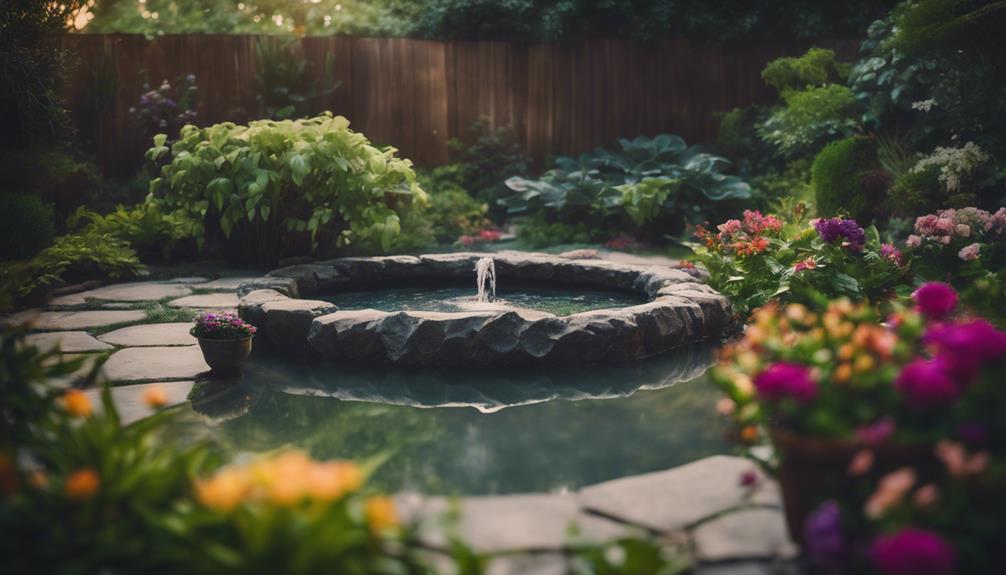You can create a beautiful DIY garden water feature by blending visual elements, natural surroundings, and soothing sounds. Incorporate natural materials like rocks, plants, and water lilies to evoke a sense of serenity and connection to nature. Strategically use lighting to create a peaceful ambiance, and choose a unique container that reflects your style. Balance form and function by designing a low-maintenance system with a harmonious flow path. Consider the landscape's harmony and balance when positioning your water feature, and don't forget to incorporate sensory elements that appeal to the senses. Now, explore the intricacies of creating your serene oasis.
Table of Contents
Key Takeaways
- Aesthetic appeal is rooted in harmony between visual elements, surroundings, and sounds, evoking an emotional response in a DIY garden water feature.
- Incorporating natural elements like rocks, plants, and water lilies creates a sense of serenity and connection to nature in a beautiful water feature.
- The style and material of the water feature's container influence its aesthetic appeal, with some styles evoking sophistication and others whimsy in a DIY garden.
- Strategically placing the water feature in areas of high visibility and accessibility, and incorporating sensory elements, creates a serene oasis in a DIY garden.
- Natural materials like stone, wood, and plants, combined with soft lighting, create harmony with nature and promote feelings of calm in a beautiful DIY garden water feature.
Understanding Aesthetic Appeal
When designing a DIY garden water feature, you'll find that its aesthetic appeal is deeply rooted in the harmony between its visual elements, surroundings, and the sounds it produces, as the human brain instinctively processes these sensory inputs together to evoke an emotional response.
By incorporating natural elements like rocks, plants, and water lilies, you can create a sense of serenity and connection to nature, reminiscent of Japanese and Zen-inspired gardens.
The strategic use of lighting can also profoundly impact the aesthetic appeal of your water feature. Soft, warm lighting can create a peaceful ambiance, while brighter, more vibrant lighting can create a dramatic and energetic atmosphere.
Additionally, the style and material of the water feature's container can greatly influence its aesthetic appeal, with some styles evoking sophistication and others whimsy.
Selecting the Right Materials
As you craft a DIY garden water feature that resonates with your personal style, you'll need to choose materials that not only complement your design vision but also withstand the elements and water exposure.
Natural stone, such as bluestone or fieldstone, is a durable and aesthetically pleasing option for DIY water fountains.
Ceramic or terra cotta pots can add a touch of elegance and whimsy, but may require additional sealing to prevent water damage.
If you're looking for an eco-friendly option, consider repurposing recycled materials like old boots or birdbaths as unique water feature containers.
Metal materials, such as copper or bronze, can create a modern and sleek look, but may require additional maintenance to prevent corrosion.
When using concrete or fiberglass, don't forget to add a waterproof coating to guarantee the material can withstand exposure to water.
With the right materials, you'll be able to create a beautiful and functional DIY garden water feature that complements your outdoor space and showcases your personal style.
Incorporating Natural Elements
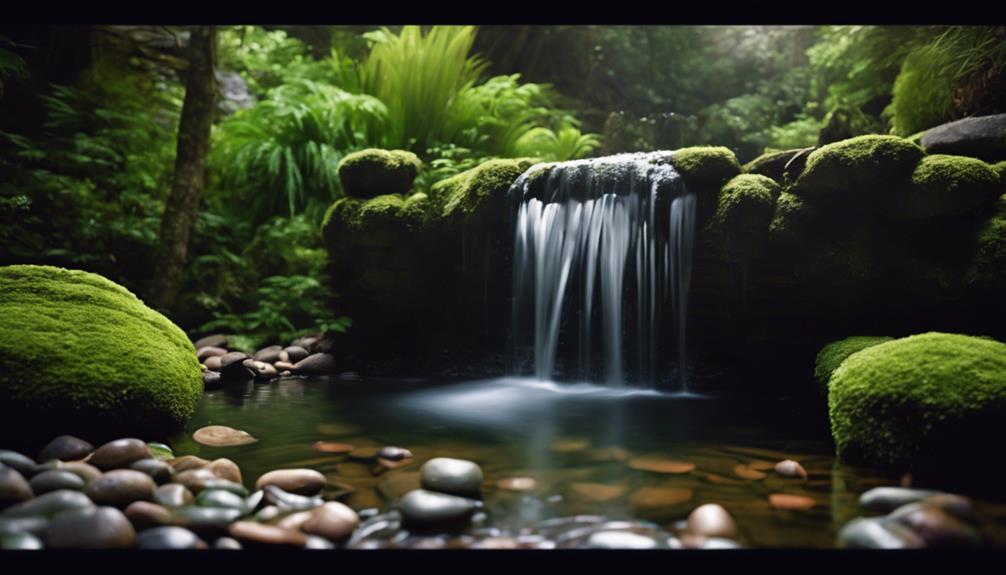
You'll enhance the visual appeal of your DIY garden water feature by incorporating natural elements, such as plants, rocks, and driftwood, which will create a sense of harmony between the water feature and its surroundings.
By blending these elements, you'll create a visually stunning display that invites relaxation and connection with nature.
For instance, consider adding a rock water fountain, where water flows gently over stones, creating a soothing melody.
You can also incorporate plants with varying textures and colors to add depth and visual interest.
Driftwood or branches can be strategically placed to create a sense of movement and flow.
When choosing natural elements, select items that complement the color palette and style of your garden.
This will guarantee a cohesive look that makes your water feature feel like a natural extension of your outdoor space.
Designing for Low Maintenance
When designing your DIY garden water feature, you'll want to focus on three key elements to guarantee low maintenance: pump selection, water flow design, and regular inspections.
By choosing the right pump and designing a water flow that meets your needs, you'll reduce the likelihood of system failures and minimize maintenance tasks.
Pump Selection
Selecting the right pump for your DIY garden water feature is crucial, as it directly impacts the overall aesthetic and maintenance requirements of your design.
For a small to medium-sized fountain, a 300 gph submersible pump provides sufficient flow, while a 200 gph pump is perfect for a smaller, gurgling flow.
When choosing a pump, consider installing a restrictor valve to adjust the flow, allowing you to customize the sound and visual appeal of your DIY fountain.
Opt for low-voltage pumps, which are safer, easier to install, and eliminate the need for an electrical permit and deep wire burial.
You'll only need to bury the wiring an inch or two below grade, and GFCI protected outlets aren't required, making installation simpler and more cost-effective.
Water Flow Design
With your pump chosen, it's time to focus on designing a water flow that complements your fountain's aesthetic while minimizing maintenance needs.
A key consideration is the flow rate, which profoundly impacts the overall ambiance of your water feature. Faster flows create a more energetic atmosphere, while slower flows produce a calming ambiance.
To achieve a natural, low-maintenance water flow design, consider using a pump with a built-in flow control or installing a separate flow control valve to regulate the water's movement. A simple, smooth flow path is also vital in reducing the likelihood of clogs and debris accumulation.
This design approach won't only enhance the visual appeal of your water feature but also make maintenance a breeze. By incorporating a pump with a built-in filter or strainer, you'll further minimize the risk of clogs and guarantee your water feature remains clean and clear.
Regular Inspections
To guarantee your DIY garden water feature remains a serene oasis and not a maintenance nightmare, you'll want to establish a regular inspection routine to catch potential issues before they escalate into costly problems.
Aim to inspect your water garden every 1-3 months, depending on its complexity and usage. During these checks, scrutinize the pump, pipes, and other components for signs of wear and tear, replacing them promptly to prevent damage to the entire system.
Inspect electrical components, like the pump and lighting, to verify they're functioning properly and safely. Make any necessary adjustments or repairs to avoid electrical hazards.
Regularly clean the water feature's basin, pipes, and pumps to prevent clogging and maintain peak water flow. Use a soft-bristled brush and mild detergent as needed.
Perform seasonal inspections to prepare your water feature for extreme weather conditions. For instance, winterize your system by draining and storing the pump, and protecting the feature from freezing temperatures.
Considering Landscape Harmony
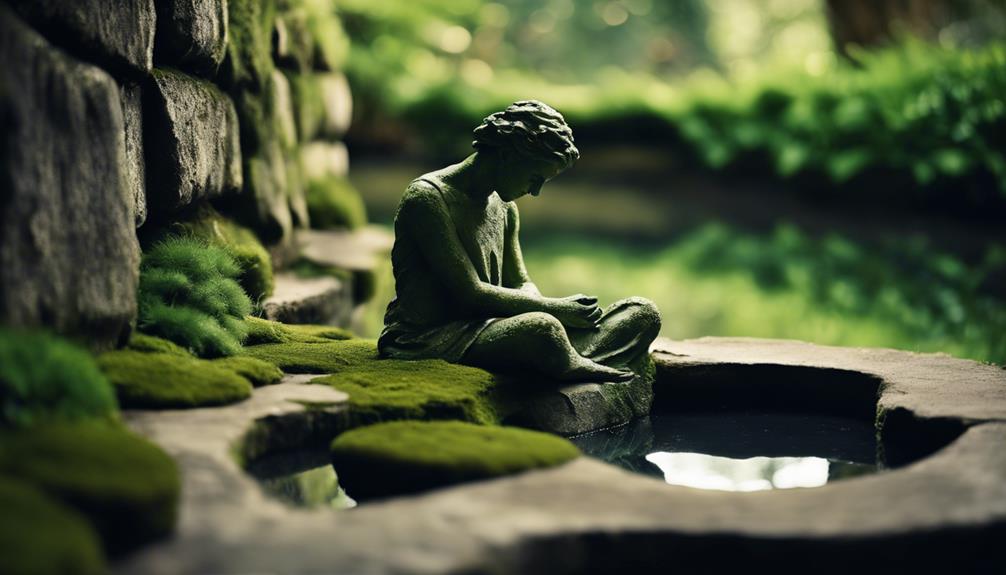
As you plan your DIY garden water feature, you're not just designing a standalone element – you're creating a harmonious relationship between the water feature and its natural surroundings.
You'll want to ponder how the feature's style, scale, and materials blend with the existing landscape, ensuring a cohesive visual flow.
Natural Surroundings Blend
Your garden's unique character emerges when you carefully blend the water feature with its natural surroundings, ensuring a harmonious balance that echoes the landscape's inherent beauty.
A water wall, for instance, can be designed to complement the existing terrain, creating a seamless fusion of natural and man-made elements. To achieve this, consider the color palette and textures of the surrounding landscape. For example, if your garden features earthy tones and rustic stone, choose a water feature with a natural stone or concrete finish to blend in.
Visualize the water feature as an extension of the natural surroundings, rather than a separate entity. This will help you create a cohesive look that feels organic and inviting.
Pay attention to the scale of the water feature, ensuring it's proportional to the surrounding landscape. Avoid overwhelming the space with a feature that's too large or too small.
Water Feature Harmony
Position your water feature to harmonize with the landscape's existing harmony by mirroring the natural curves and lines of the surrounding terrain. This will create a sense of cohesion, making your beautiful water feature blend seamlessly into its environment.
Consider the landscape's dominant shapes, textures, and colors, and reflect them in your water feature's design. For instance, if your garden has winding pathways, incorporate curved edges or meandering streams into your water feature. This harmony will create a sense of balance and visual flow, drawing the viewer's eye through the garden.
To achieve perfect harmony, also consider the water feature's scale and proportion. Guarantee it's not overwhelming or underwhelming in relation to the surrounding landscape. A well-proportioned water feature will create a sense of unity, making your garden feel more cohesive and inviting.
Exploring Unique Container Options
As you design your DIY garden water feature, don't settle for a traditional container.
Five unusual vessel options – a vintage bathtub, a repurposed wooden boat, a large urn, a galvanized tub, and a sculpted stone basin – can add an artistic twist to your creation.
Each of these unique containers offers a chance to express your personal style and create a one-of-a-kind focal point in your garden.
Consider a vintage bathtub, for instance, which can evoke a sense of nostalgia and whimsy.
Alternatively, a repurposed wooden boat can bring a touch of rustic charm to your outdoor space.
If you're looking for something more elegant, a large urn or sculpted stone basin can add a sophisticated touch.
Even a galvanized tub can be transformed into a beautiful water feature with the right design elements.
Think outside the box – or in this case, the flower pot or tea pot – and choose a container that reflects your personality and complements your garden's aesthetic.
With a little creativity, you can turn an unusual vessel into a stunning DIY garden water feature that becomes the envy of your neighborhood.
Creating a Peaceful Atmosphere
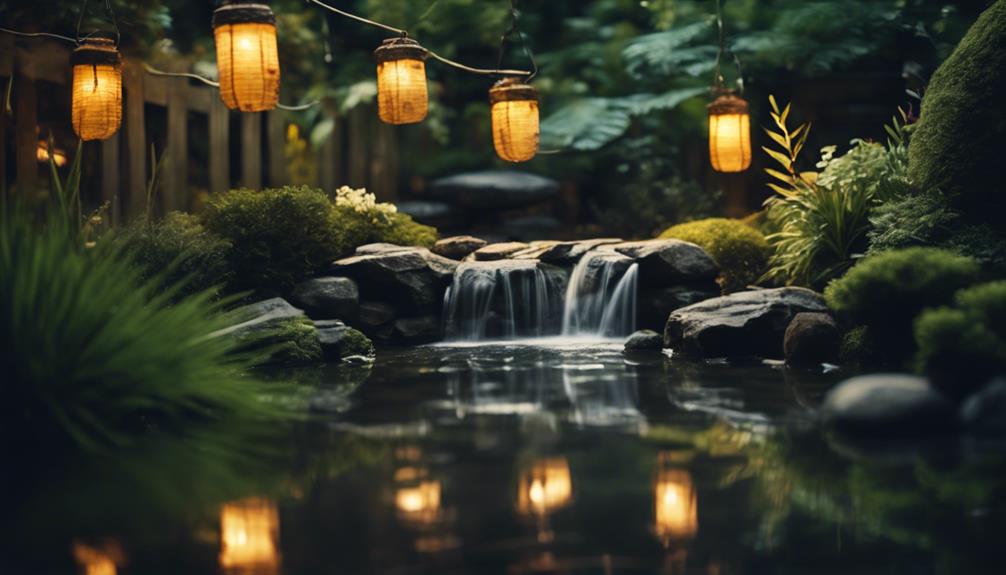
By incorporating sensory elements that appeal to your senses, you can transform your DIY garden water feature into a serene oasis that envelops you in tranquility.
Strategically place your water feature, such as a fountain or pond, in areas of high visibility and accessibility to maximize its calming effects.
Natural materials like stone, wood, and plants will create a sense of harmony with nature, promoting feelings of calm and relaxation.
As the sun sets, the use of lighting, such as a soft, warm glow or subtle color-changing effects, can enhance the ambiance of your DIY garden water feature, creating a peaceful atmosphere in the evening or at night.
To fully immerse yourself in the peaceful atmosphere, consider adding a seating area or quiet nook near your garden water feature.
This will invite relaxation and contemplation, allowing you to unwind and recharge.
Balancing Form and Function
When designing your DIY garden water feature, you'll need to strike a delicate balance between aesthetics and practicality, combining visually appealing elements with functional components to create a harmonious and efficient system.
A beautiful water fountain or stone fountain, for instance, can be enhanced by incorporating natural elements like rocks or waterfalls, which add visual interest while creating a sense of serenity.
However, functionality is vital, as it guarantees the system operates efficiently and requires minimal maintenance.
To achieve this balance, consider using materials and designs that serve both purposes.
For example, you can use decorative ceramic pots that also house the water pump and filtration system.
By doing so, you'll create a visually appealing feature that's also low-maintenance.
Achieving Serenity in the Garden
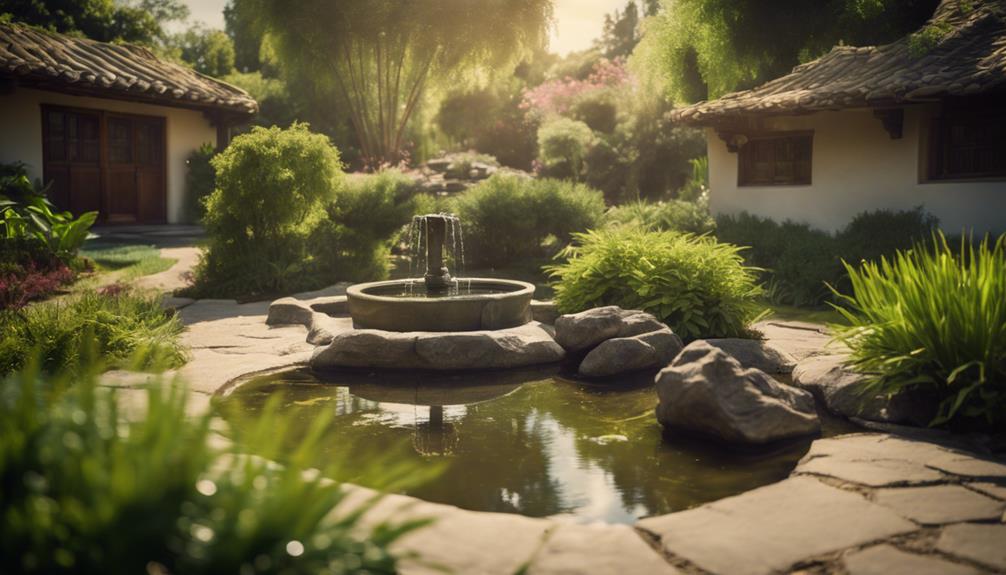
You can evoke a sense of serenity in your garden by carefully selecting and placing water feature elements that create a calming atmosphere, such as gentle trickles, soft ripples, or soothing sounds.
Consider incorporating a pot fountain, which can add a touch of elegance while creating a peaceful ambiance. The gentle flow of water from the fountain's spout will create a mesmerizing visual effect, drawing your attention to the present moment.
To enhance the serenity of your garden, position the water feature in a way that creates a sense of seclusion or privacy.
You can achieve this by placing it in a secluded corner or surrounded by lush greenery. The sound of running water will help mask any background noise, creating a sense of tranquility.
Additionally, consider adding some comfortable seating nearby, allowing you to sit and relax while taking in the soothing sights and sounds of your DIY garden water feature.
Frequently Asked Questions
How to Make Your Own Water Feature Outdoor?
You'll create a stunning outdoor water feature by exploring pondless ideas, like wall-mounted fountains or bubbler systems, and finding fountain inspiration online or in nature, then incorporating unique elements that reflect your personal style.
How Do I Choose a Garden Water Feature?
As you ponder the perfect addition to your outdoor oasis, you're faced with a pivotal decision: choosing a garden water feature that resonates with your personal style, while also respecting your budget constraints, don't you?
What Is the Easiest Water Feature to Maintain?
You'll find that solar-powered fountains are the easiest to maintain, as they don't require wiring or electricity, and their solar panels can be easily cleaned with a soft brush, promoting water conservation and low maintenance.
What Do You Need for an Outdoor Water Feature?
You'll need a million things, but let's start with the essentials: a reliable water pump to circulate and aerate the water, a power source to keep it running, and a reservoir to hold it all together, complete with a soothing fountain noise that'll be music to your ears!
Conclusion
As you step into your serene DIY garden water feature, the soothing sounds and visually stunning design transport you to a state of tranquility.
Consider the example of a small, rustic pond surrounded by lush greenery, where a gentle waterfall cascades into a tranquil pool, creating a sense of harmony.
By balancing form and function, incorporating natural elements, and designing for low maintenance, you can create a breathtakingly beautiful water feature that becomes the focal point of your garden oasis.

